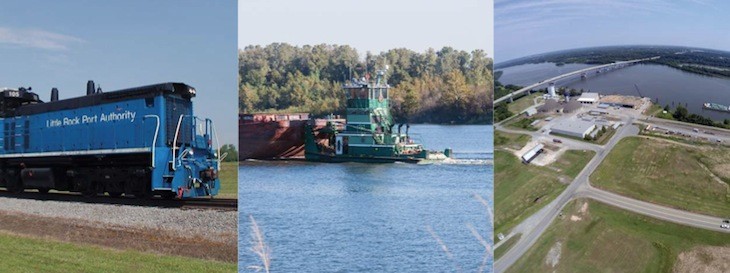Transportation Secretary Buttegeig joins Arkansas officials for LR Port’s 50th anniversary
by June 7, 2021 6:33 pm 1,360 views

In 1943, research began on a massive infrastructure project in the heart of the mid-south. The McClellan-Kerr Navigation System, completed in the early 1970’s, has become an economic engine that spurred the growth of the port system along the Arkansas River and other waterways in the region that tie into it.
A panel convened Monday (June 7) in Little Rock to discuss the 50-year anniversary of the project. Speakers included Gov. Asa Hutchinson and U.S. Secretary of Transportation Pete Buttigieg.
The 445-mile navigation channel begins at the confluence of the White and Mississippi Rivers and proceeds one-half mile upstream on the White River to the Montgomery Point Lock and Dam, according to the U.S. Army Corps of Engineers. From there, the channel proceeds nine miles upstream on the White River to the man-made Arkansas Post Canal, and then nine miles through the canal to the Arkansas River. The McClellan-Kerr Arkansas River Navigation System crosses the state of Arkansas into Oklahoma traversing the state until it reaches the confluence of the Arkansas and Verdigris River where the navigation channel follows the Verdigris River terminating fifty-one miles upstream at the Port of Catoosa, near Tulsa, Oklahoma, the Corp reports.
Hutchinson noted that the research for the project, which helps move products and people along the waterways in the region, started in 1943, but it wasn’t funded until 1956 and it took another 15 years to complete the work on the system.
Democrats and Republicans in Washington D.C. have been wrangling for weeks about the scope and size of a proposed infrastructure deal.
Buttigieg said people in the country need to realize that infrastructure projects like the system propel local and regional economies. He noted that President Joe Biden wants to spend $17 billion to improve inland waterway systems as a part of his infrastructure plan.
“We have to have a broad imagination about where the opportunities (for economic development) lie,” he said. “We have to decide if we only want to benefit from what previous generations have done.”
He later added that he hopes future generations will be able to look back at the work done in the early 2020s as a model of how to develop a vibrant economy.
Hutchinson said the project was started while Franklin Roosevelt was president and it was dedicated by President Richard Nixon. He said it shows that bi-partisanship is critical to moving our country’s infrastructure needs forward.
The system took decades to complete, and it could only be done by both parties cooperating with a shared vision.
“It shows how long major infrastructure projects take to complete in our country,” he said.
Despite the success of the system, challenges remain, Hutchinson said. More than 20 years ago the system’s channel depth was studied and it needs to be deepened from nine feet to 12 feet. It’s been so long since that study was done that a new one is now underway.
The levee system along the waterways has vulnerabilities that need to be fixed and that will require money and time, he said. Flood control impacts water traffic along with the farmlands that border these waterways, he added.
Little Rock Mayor Frank Scott Jr. echoed the sentiments of the governor and the transportation secretary. Years ago, projects like this were seen as a way to improve a region’s economy and not a waste of taxpayer dollars.
“50 years ago, it was seen as an economic connector,” he said.
